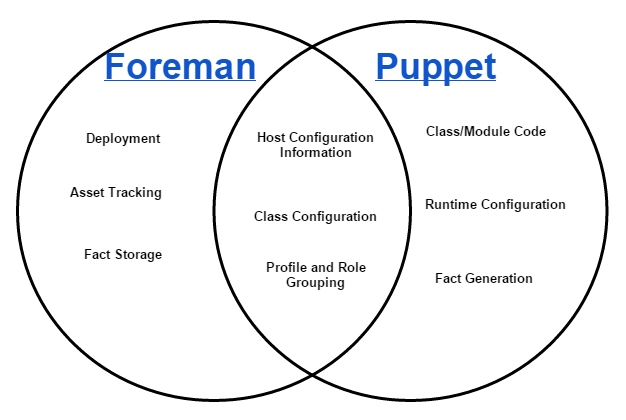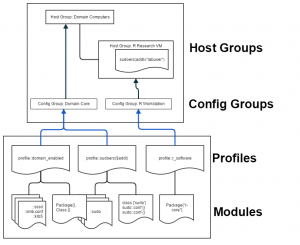This describes our assignment of responsibility between Foreman and Puppet. For an overview, please see Part I .
Old Configuration
Our original configuration relied primarily on Foreman to define services, required classes and their supply configuration parameters. This left puppet to solely provide a mix of modules (ie autofs, etc) and profile-like classes which would be glued together by foreman at the Host Group level. When we started down the path we were on Ubuntu 12.04 (~2013) and running Foreman 1.2 or 1.3. Config Groups were not yet and option and the UI tended to force most configuration overrides to occur when configuring classes.
At first, this configuration worked well, however it soon became unwieldy list of classes (400+) that were listed in foreman and the assignment per host started to get quite cluttered. For example the configuration of a research VM running our standard R setup was three Host Groups deep, and had 27 different classes whose configuration was keyed off a mix of host group and domain. Managing this, and determining what got applied where and ensuring configuration changes didn’t have unintended side effects became a burden. Additionally, adding new classes meant weeding through the 400+ included to find what you needed. In addition, as the groupings and configuration were all in Foreman, creating a development environment was a fairly manual process of recreating the host groups and applying all the configuration overrides.
The configuration we were performing on classes fell into two categories, service-based config where items like db names and who has access to a service would vary depending on the service and the static configs for items like overall domain configuration, core apt repo’s that would almost never vary once setup.
In hindsight, setting up ignored_environments.yml would have saved us some heartache and led to a cleaner class list. It wouldn’t have led to clarity on the filesystem of easily knowing which modules were top level modules (ie, foreman directly applies) vs modules that were installed to fulfil dependencies.
New Configuration
In our new configuration, we realized that we needed to draw a line between where configuration and class application should occur. This can be a bit tricky as there is substantial overlap between what foreman provides and what puppet provides.
In deciding whether foreman or puppet should be responsible for a particular item we decided to use the following guidelines:
- Use foreman to determine what a host is. Foreman should be the starting point to seeing what classes have been applied to a host and at a quick glance give someone an idea of what services/processes should be running.
- There should be a single point of connection between foreman and puppet.
- Only service-level config in foreman, not domain or global configs.
We started by looking at the Roles and Profiles pattern in Puppet and seeing how we could adapt this to Foreman. The first mapping that was pretty obvious is that a Foreman config group is a puppet role. Both do not allow parameters and both are supposed to be composed only of classes. So config groups or roles? In order to allow an admin logged into foreman to see what services are running on a host, we decided to use Foreman config groups in favor of Puppet roles.
The next step was to reduce the surface area between foreman and puppet to clearly defined lines of control. Previously we had directly included any puppet module in a config group and applied configuration on foreman via smart parameters. This time, following the profile pattern, we define one profile per service and expose only these profiles to foreman by filter in ignored_environments.yml.
:filters:
- !ruby/regexp '/^(?!role|profile).*$/'
These profiles have configurable service configuration exposed to foreman as parameters. Where possible, sane defaults for our environments are provided if we decide to even expose a parameter rather than configure it in the profile class. These profiles are combined using config groups and applied to Host Groups. The diagram below shows roughly what this looks like:
What about Hiera?
We considered using Hiera to manage global configuration options, but after mocking up some workflows and seeing how little data we would actually have in it vs foreman decided to just put those configuration values in the various profiles. A second reason for not using Heira was to reduce the number of places to look for configuration. While not too bad, using Hiera would have let to a second code repo which would have required careful synchronization with the main puppet code repo. We may revisit this in the future as the need arises.


